The WD Black2 is a combination drive for portable users that presents both a 1TB HDD and 120GB SSD to the host system leveraging only a single SATA port. Rather than only enhance their hybrid HDD portfolio, WD Labs came up with the idea to essentially sandwich two drives together. The architecture is both novel and pretty impressive. Each drive is managed by a controller that plays traffic cop, directing the IO to each drive from the single SATA port. The drive comes in just the single 1TB/120GB capacity point and has a 9.5mm 2.5″ form factor.
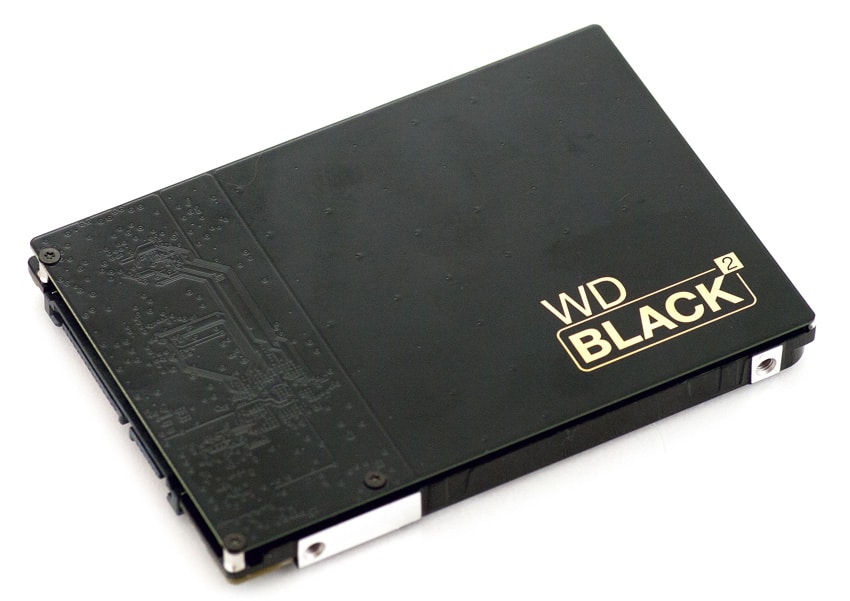
Breaking down the two components, WD is using a 5400RPM 1TB hard drive (WD Blue Slim) that takes up most of the physical space. Glued on top and bridged via the controller chip, is a 120GB SSD that’s powered by a JMicron controller. This obviously marks the first SSD effort WD has embarked on since their unsuccessful attempt with the SiliconEdge SSDs in early 2010. WD quotes performance figures for the SSD of 350MB/s read and 140MB/s write through the SATA 6Gb/s interface. Compared to modern dedicated SSDs these numbers are well below industry norms, but that’s attributable largely to the split interface limitation in the WD Black2 architecture. WD does not quote performance figures for the HDD portion of the drive, however they should be in line with the Blue Slim HDD.
Understanding exactly what the Black2 is, is critical to understanding where WD hopes it will play in the market. This is of course a drive designed for the mobile market; specifically full size notebooks that house a 9.5mm drive bay. The addressable market is actually smaller than that though; it’s really just notebooks that have the 9.5mm drive bay and no other expansion options for an SSD via second drive bay, mSATA slot or removable optical drive bay (should the user decide to remove it for storage). WD is banking that many users would appreciate the simplicity of a single drive sandwich solution, but as this is targeted largely to enthusiasts, market acceptance for the design will be the deciding factor in the success or failure of the Black2 idea. Beyond just the hardware adoption challenges though, WD only supports Windows with this release. As a result, Mac users are entirely left out, slicing off a good number of the enthusiasts WD hopes to attract.
The Black2 comes in a retail package that includes the drive, SATA cable for external connection and USB key that provides web access to the requisite drivers (offline drivers are not included in the retail package at the time of launch). The 1TB/120GB Black2 carries an MSRP of $299 and comes with a five year warranty.
The WD Black2 Specifications
- Model Number: WD1001X06XDTL
- Interface: SATA 6 Gb/s
- Form factor: 2.5-inch
- Performance (SSD): 350MB/s read, 140MB/s write
- Load/unload cycles: 600,000
- Non-recoverable read errors per bits read: <1 in 1014
- Limited warranty (years): 5
- Average power requirements (W)
- Read/Write: 1.8
- Idle: .9
- Standby/Sleep: .9
- Temperature (°C) Operating: 0 to 60
- Non-operating: -40 to 70
- Shock (Gs)
- Operating (2 ms, write): 30
- Operating (2 ms, read): 65
- Non-operating (2 ms): 350
- Acoustics (dBA)
- Idle: 20
- Seek (average): 21
- Physical Dimensions: 9.5mm x 100.20 x 69.85
- Weight (lb./kg, ± 10%): 0.28/0.125
Design
The WD Black2 is a hybrid SSD/HDD with a 1TB HDD and 120GB SSD merged together. The HDD side of the WD Black2 is the Blue Slim (down to the white product label visible after dismantling the drive) which had an additional SATA bridge added to combine both drives. Another difference compared to the Blue Slim is the Black2 has a larger 9.5mm height with the SSD sandwiched on top.
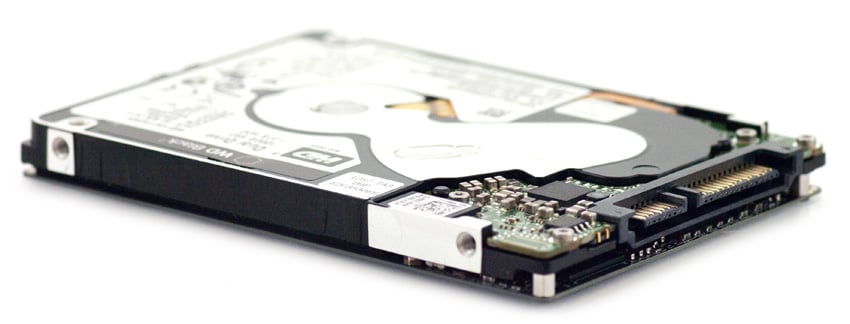
Looking at the front of the drive, we see the same industry standard SATA power and data connection, which makes this drive universally compatible from a hardware point of view. Software compatibility-wise the Black2 is currently only compatible with Windows-based platforms. One interesting aspect of this new WD Black2 is the top cover is both product label and SSD circuit board.
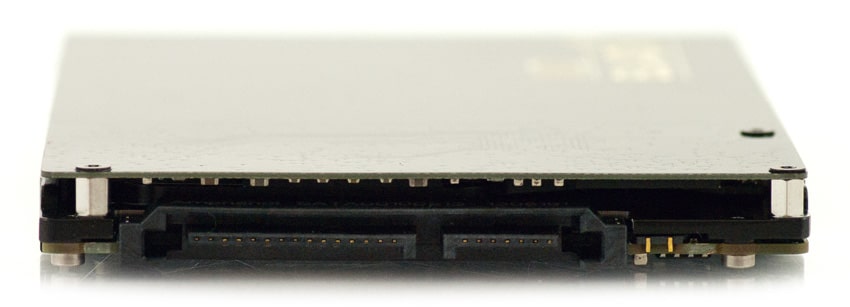
The circuit board design on the WD Black2 is the same as the Blue Slim with the addition of a Marvell SATA bridge chip to allow the single SATA interface to communicate to both the SSD and HDD through the same partition mapping.
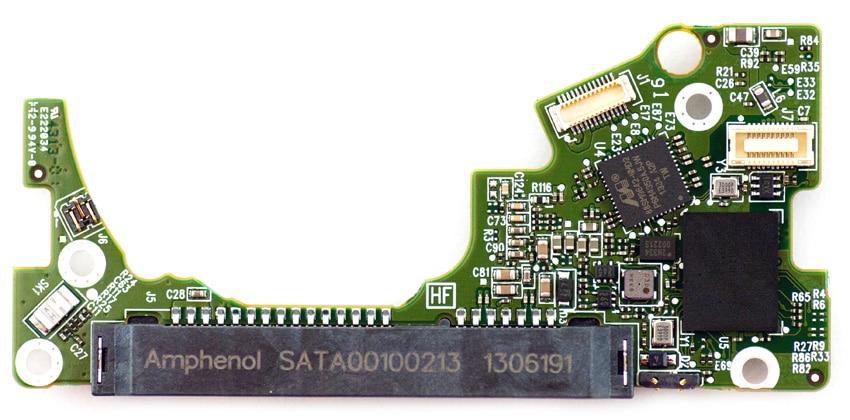
After carefully removing the top layer of the WD Black2 we find the NAND and controller board for the SSD section of this drive. WD uses a JMicron controller along with two 64GB MLC NAND packages in this layout, along with a NANYA DRAM package.
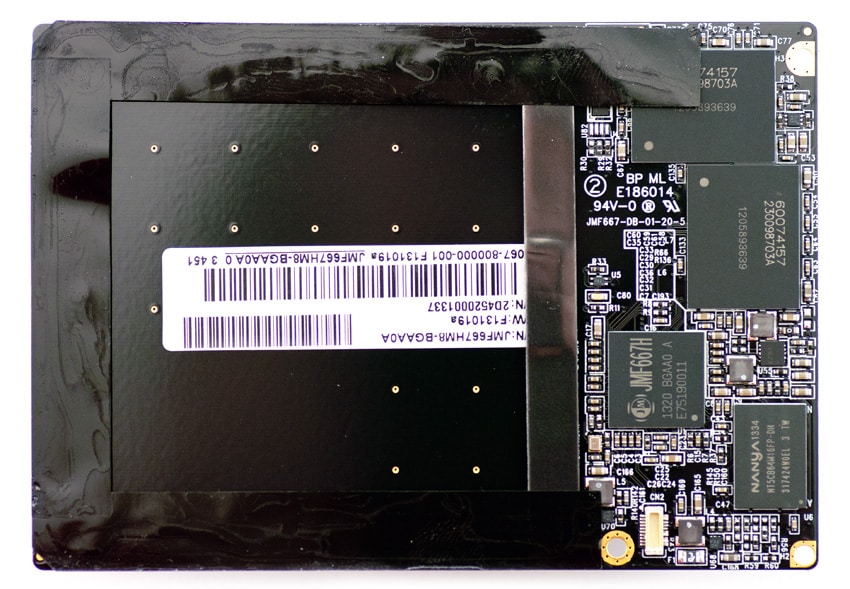
Usability
Before getting started with the WD Black2 the user needs to go through a few configuration steps. WD includes a USB key with the retail packaging that when inserted directs the user to a WD site for downloading the requisite drivers. It should be noted that the drivers were not ready in time for the first retail packages, so an Internet connection is required to set up the drive the first time right now, though later releases should include the drivers in the kit. Initially just the SSD portion of the drive is exposed, when the drivers are installed the user will see both drives through Windows. WD recommends putting a fresh install of the OS on the SSD portion of the drive but also includes cloning software to facilitate an easy migration if the previous OS footprint is smaller than the 120GB SSD capacity.
HDD Consumer Synthetic Benchmarks
In testing this drive we first broke out the benchmarks in HDD only and SSD only dedicated scenarios.
All consumer HDD benchmarks are conducted with the mid-range StorageReview Consumer Testing Platform. The comparables used for the review below include:
- Hitachi Travelstar Z7K500 (500GB, 7mm)
- Hitachi Travelstar Z5K500 (500GB, 7mm)
- Western Digital Scorpio Blue (500GB, 7mm)
- WD Blue UltraSlim (500GB, 5mm)
- Seagate Laptop Ultrathin (500GB, 5mm)
All IOMeter figures are represented as binary figures for MB/s speeds.
Using our Consumer Testing Platform, we measured 2MB Sequential speeds, and the WD Black2 came in at 106MB/s read and 107MB/s write, placing it in the lower-middle of the pack and a hair behind the Blue Slim 1TB on its own. The overhead for the extra controller chip is probably to blame, though it’s pretty minor in this scenario.
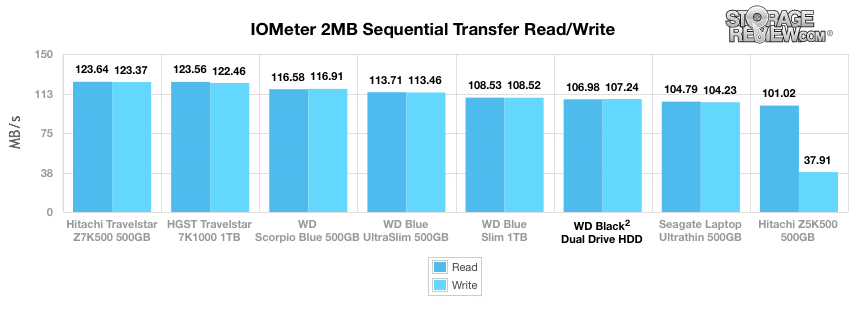
For the 2MB Random Transfer testing, the WD Black2 came in at 46MB/s read and 47MB/s write, placing it in the middle of the group, again slightly lower than the WD Blue Slim.
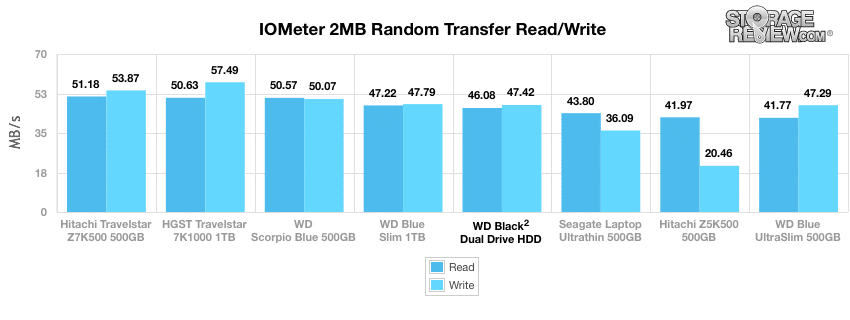
In the 4k Random Transfers MB/s, the WD Black2 measured 0.218MB/s read and 0.616MB/s write, or 55.83 IOPS and 157.66 IOPS respectively.
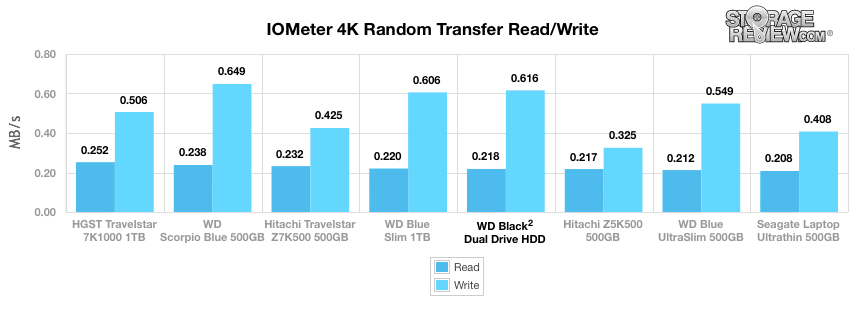
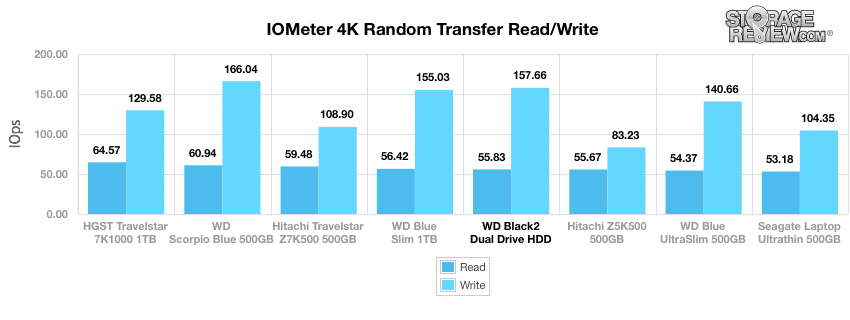
In our 4k Write Latency, the WD Black2 posted an average 4k write latency of 6.34ms, just behind the WD Scorpio Blue. For max 4k write latency, it posted 17.87ms, which came in right below the Blue Slim.
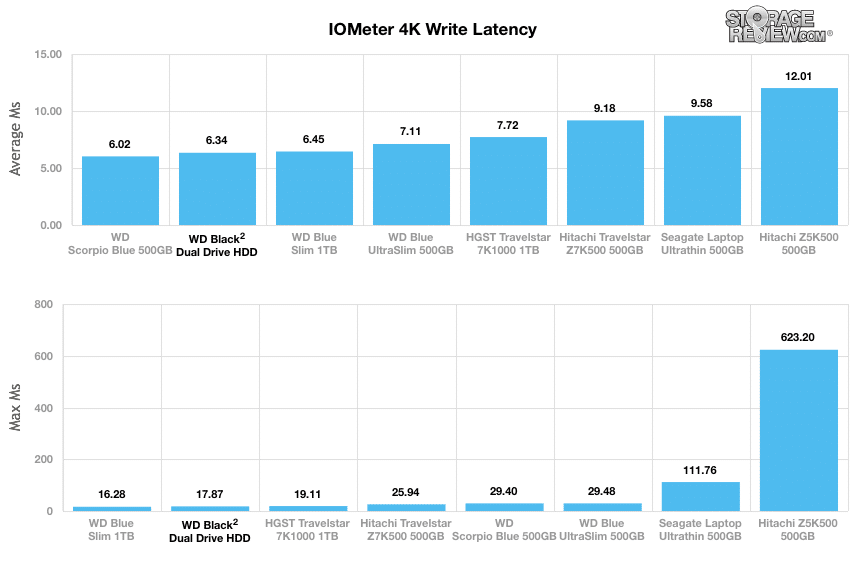
Our last series of synthetic benchmarks compares the hard drives in a series of server mixed-workloads with a queue depth of ranging from 1 to 128. Each of our server profile tests has a strong preference towards read activity, ranging from 67% read with our database profile to 100% read in our web server profile. In all of our mixed workloads, the WD Blue Slim performed near the top of the group.
The first test is our database profile, with a 67% read and 33% write workload mix primarily centered on 8k transfer sizes.
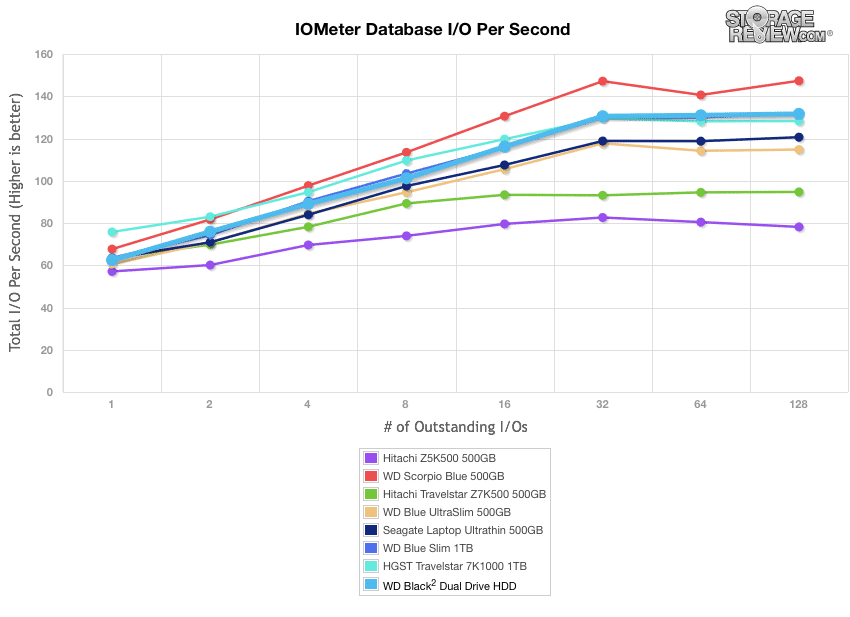
The next profile looks at a file server, with 80% read and 20% write workload spread out over multiple transfer sizes ranging from 512-byte to 64KB.
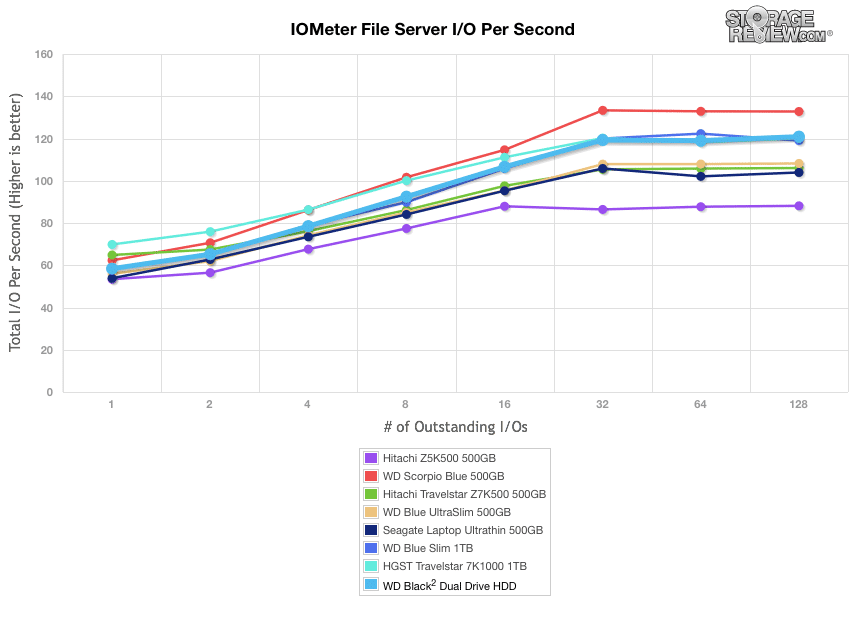
Our web server profile is read-only with a spread of transfer sizes from 512-byte to 512KB.
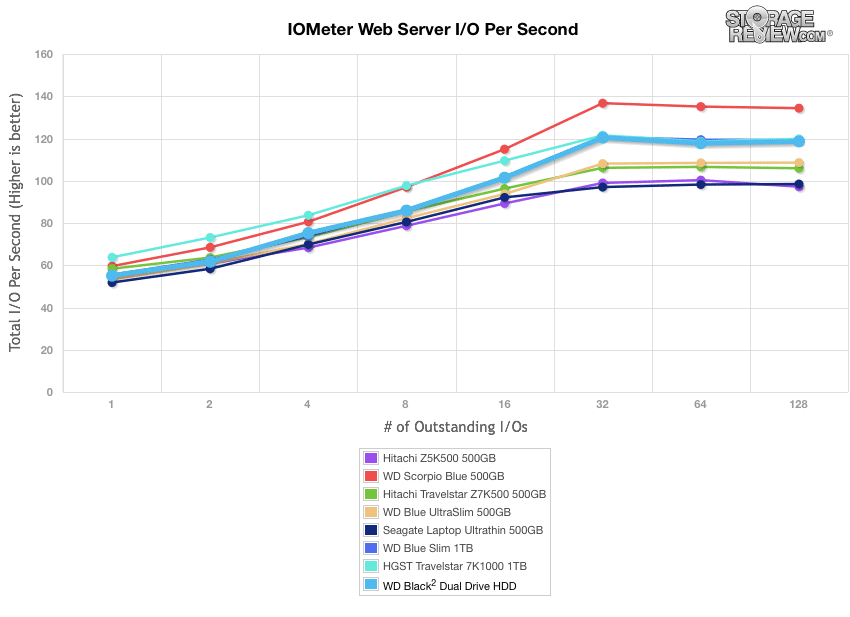
The last profile looks at a workstation, with a 20% write and 80% read mixture using 8k transfers.
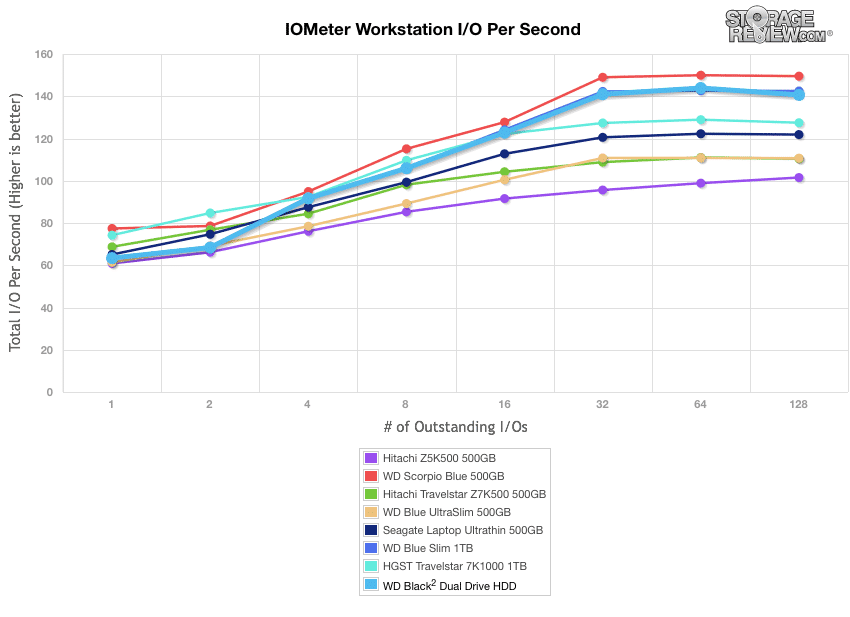
HDD Consumer Real-World Benchmarks
For the average consumer, trying to translate random 4k write speeds into an everyday situation is pretty difficult. It helps when comparing drives in every setting possible, but it doesn’t exactly work out into faster everyday usage or better game loading times. For this reason we turned to our StorageMark 2010 traces, which include HTPC, Productivity, and Gaming traces to help readers find out how a drive might rank under their conditions.
This real-life test covers disk activity in a gaming environment. This trace relies heavily on the read performance of a drive. To give a simple breakdown of read/write percentages, the HTPC test is 64% write, 36% read, the Productivity test is 59% write and 41% read, while the gaming trace is 6% write and 94% read. The test consists of a Windows 7 Ultimate 64-bit system pre-configured with Steam, with Grand Theft Auto 4, Left 4 Dead 2, and Mass Effect 2 already downloaded and installed. The trace captures the heavy read activity of each game loading from the start, as well as textures as the game progresses. In this trace we recorded 426MB being written to the drive and 7,235MB being read.
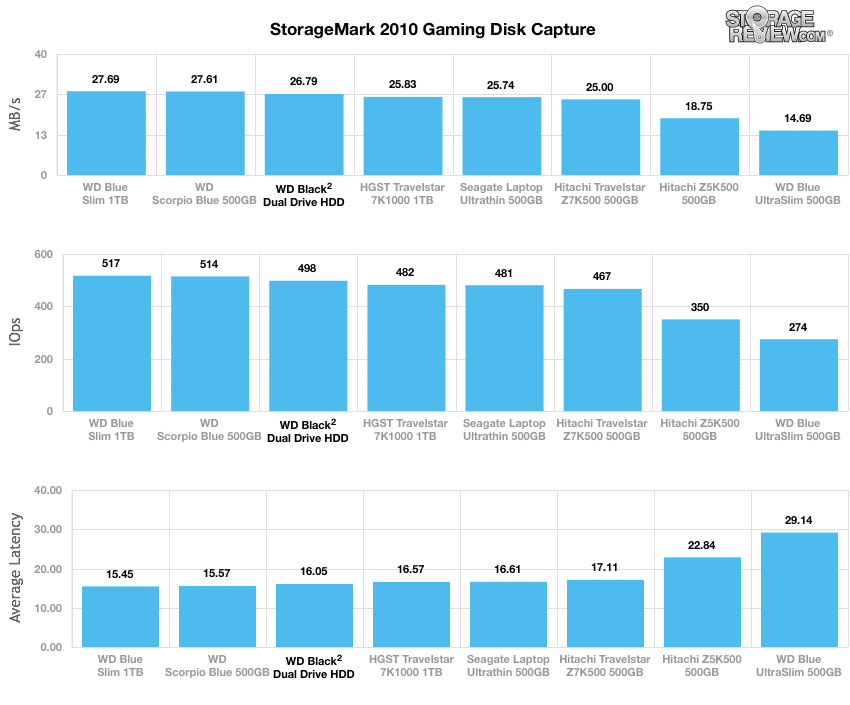
In the StorageMark 2010 gaming trace, the WD Black2 trailed behind the Blue Slim, with performance measuring 26.79MB/s average or 498 IOPS and an average response time of 16.05ms.
SSD Consumer Synthetic Benchmarks
All consumer SSD benchmarks are conducted with the mid-range StorageReview Consumer Testing Platform. The comparables used for the review below include:
- Crucial M500 (480GB, Marvell 9187, Micron 20nm MLC NAND, SATA)
- OCZ Vector (256GB, Indilinx IDX500M00-BC Barefoot 3, 25nm MLC NAND, SATA)
- Samsung SSD 840 EVO (250GB, 400MHz Samsung 3-core MCX controller, Samsung 1x nm Toggle NAND Flash, SATA)
- Seagate 600 SSD (120GB, Link-a-Media LM87800, 19nm MLC NAND, SATA)
- OCZ Vertex 150 SSD (240GB, Indilinx Barefoot 3 BF3-M10, 19nm MLC NAND, SATA)
- Corsair Force LS (240GB, 19nm Toshiba MLC, SATA)
All IOMeter figures are represented as binary figures for MB/s speeds.
In our first test measuring 2MB sequential transfer performance, we measured 449MB/s read (WD quoted 350MB/s read) with write performance measuring just 138MB/s. While read performance was fairly competitive, write performance was under half that of other SSDs in the mainstream group.
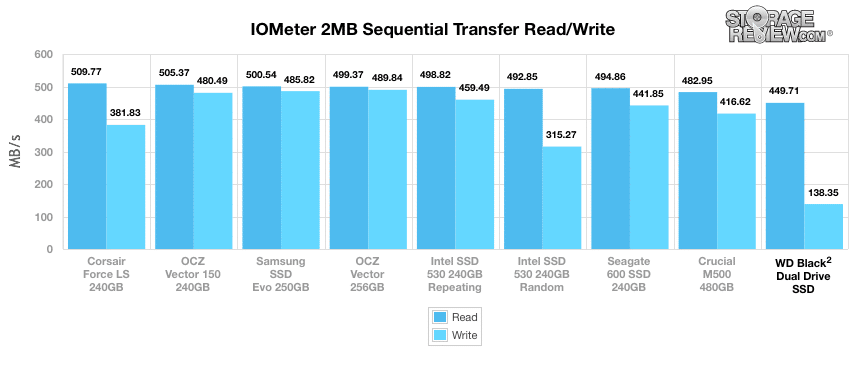
Measuring 2MB random transfer speeds, we saw bandwidth of 464MB/s read and 137MB/s write. Again read speeds stayed fairly competitive, while write performance was far under other SSDs in the group.
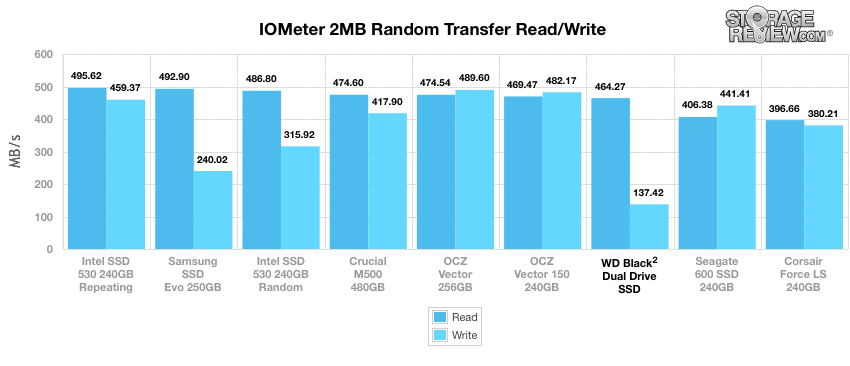
Switching to smaller 4K random transfers, the WD Black2 stood out from the rest of the pack with the strongest QD1 4K read speed measuring 52MB/s read or 13,320 IOPS. Write performance though was slightly under others in this group, measuring 68MB/s or 17,489 IOPS.
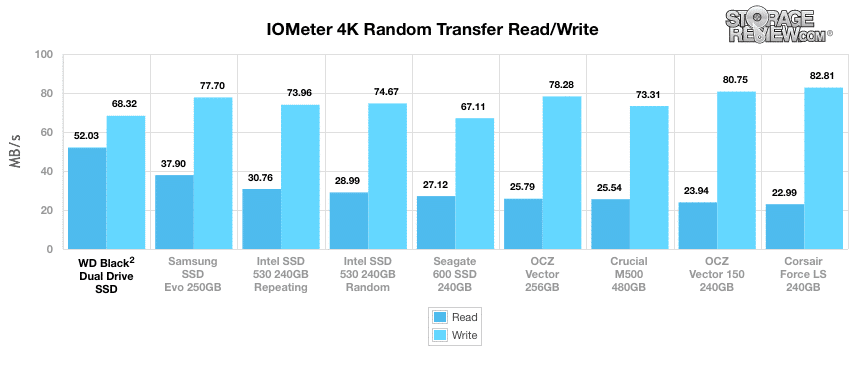
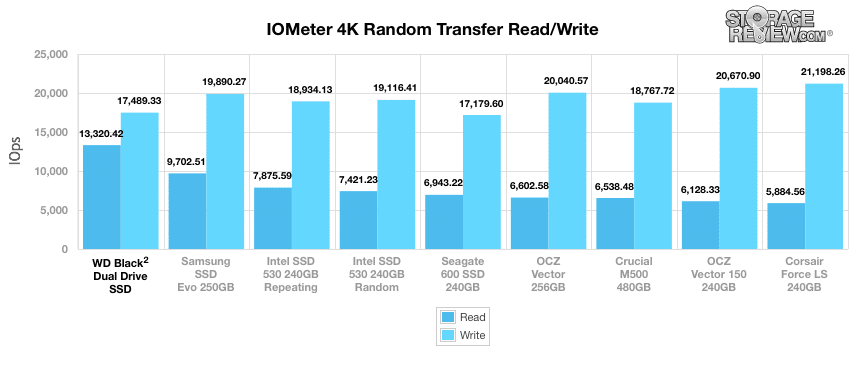
In our next test, we shift to a smaller 4k random workload with 100% read activity that scales from 1QD to 64QD. In this setting the WD Black2 scaled from 11,438 IOPS at QD1 to 59,189 IOPS at QD64. This put it into the lower part of the pack, alongside the SandForce-based SSDs working with incompressible data.
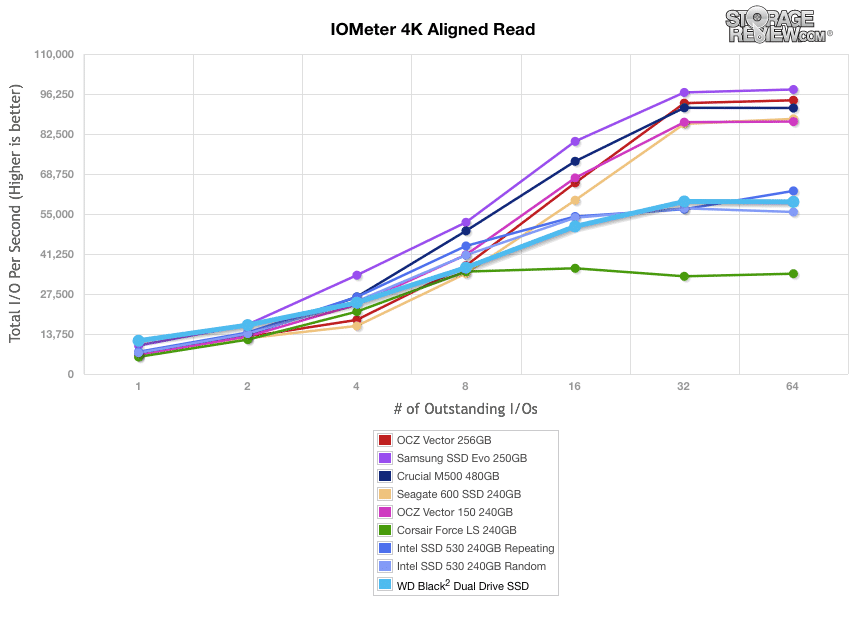
Switching from read to write performance, the WD Black2 slumped behind other mainstream SSDs, with random write throughput scaling from 19,452 IOPS at QD1 up to 31,358 IOPS at QD64. This fell far behind other SSDs in the mainstream group that peaked upwards of 90,000 IOPS.
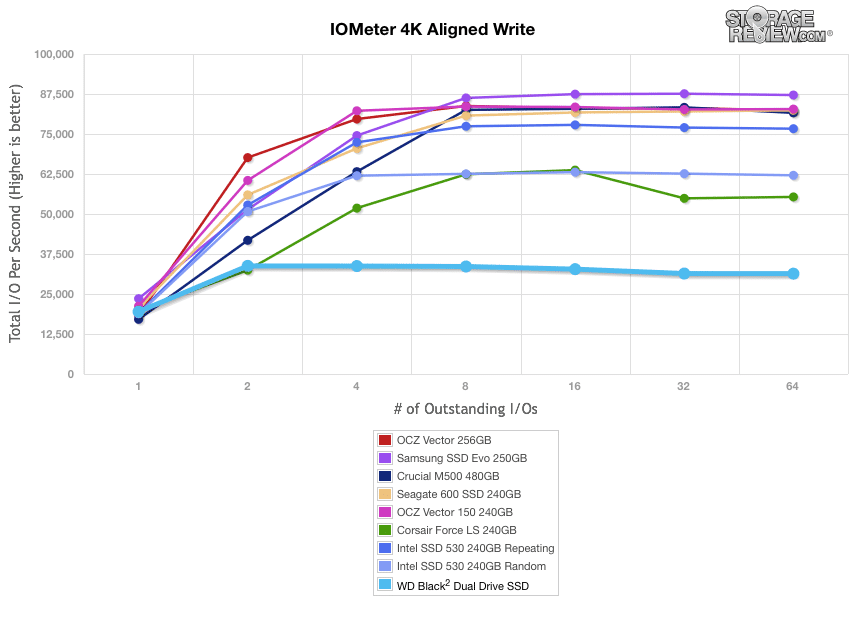
Comparing average write latency between each mainstream consumer SSD, the WD Black2 SSD ranked at the bottom of the pack with a time of 0.0567ms with a low peak latency of 1.61ms.
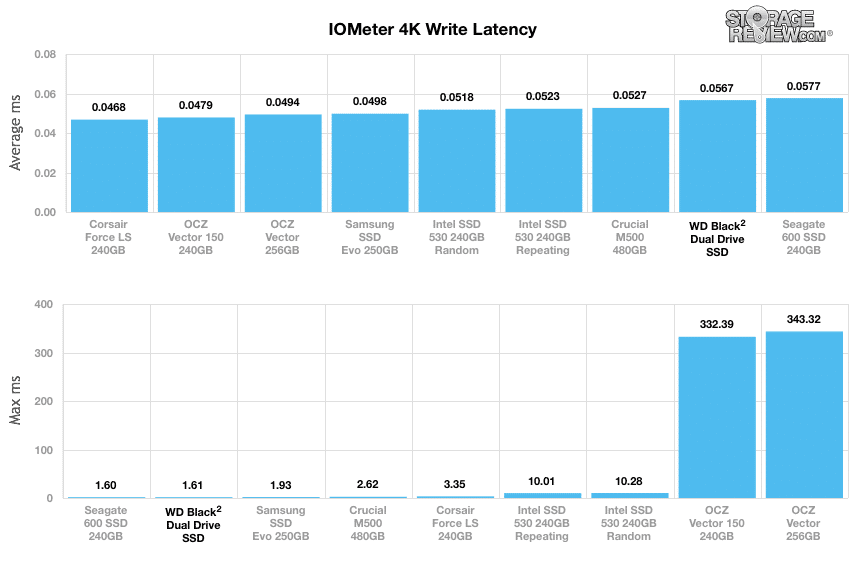
Our last series of synthetic benchmarks compare the hard drives in a series of server mixed-workloads with a queue depth of ranging from 1 to 128. Each of our server profile tests has a strong preference towards read activity, ranging from 67% read with our database profile to 100% read in our web server profile. In all of our mixed workloads, the WD Black2 SSD ranked near the bottom or lower-middle of the pack
The first is our database profile; with a 67% read and 33% write workload mix primarily centered on 8K transfer sizes.
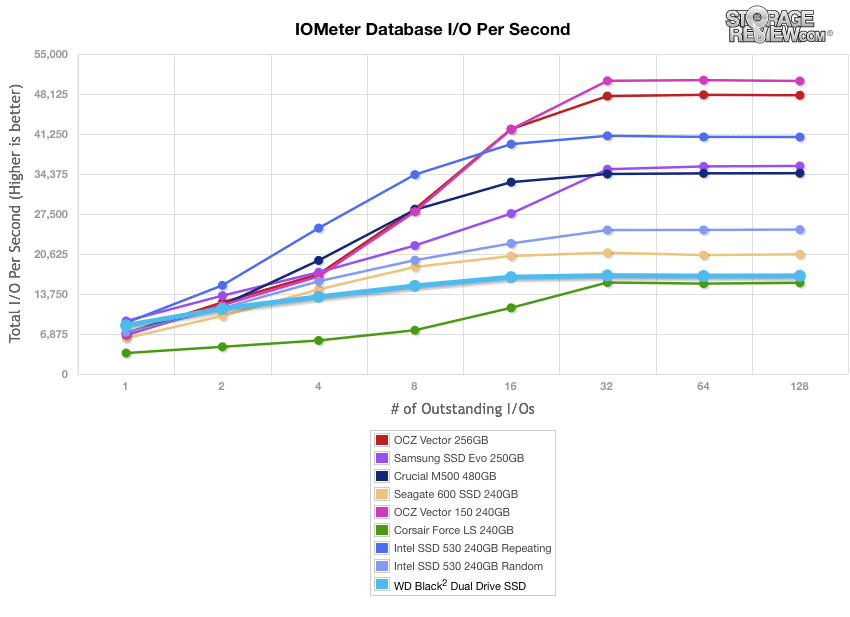
The next profile looks at a file server, with 80% read and 20% write workload spread out over multiple transfer sizes ranging from 512-byte to 64KB.
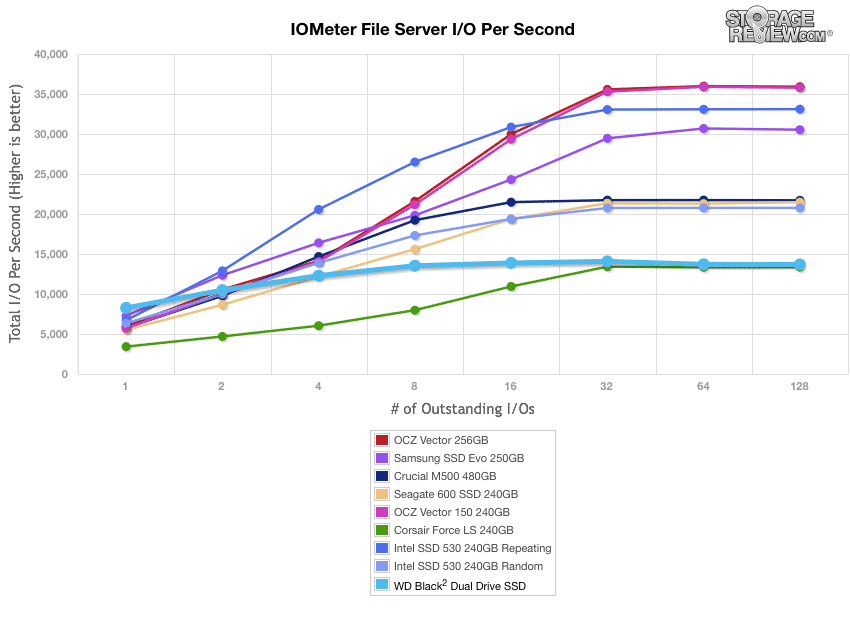
Our web server profile is read-only with a spread of transfer sizes from 512-byte to 512KB.
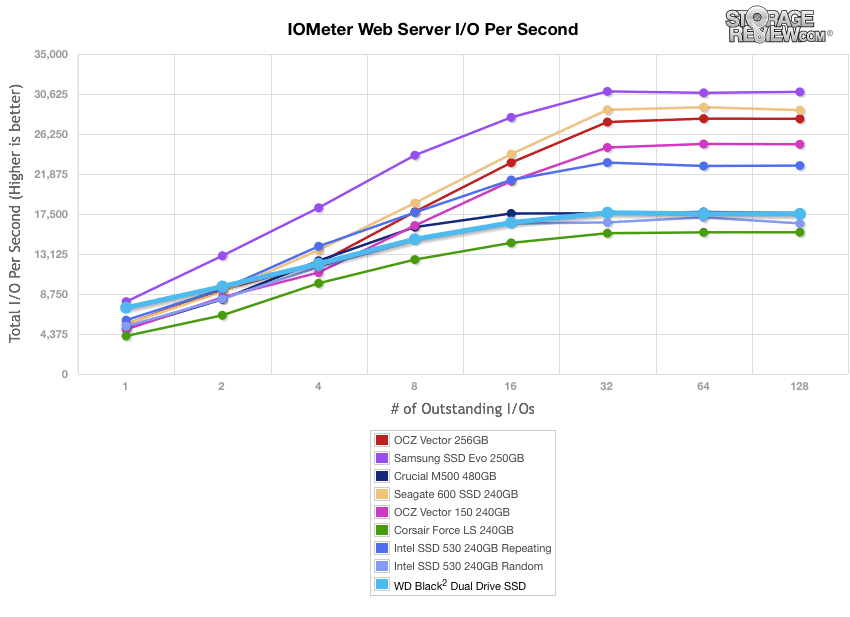
The last profile looks at workstation activity, with a 20% write and 80% read mixture using 8K transfers.
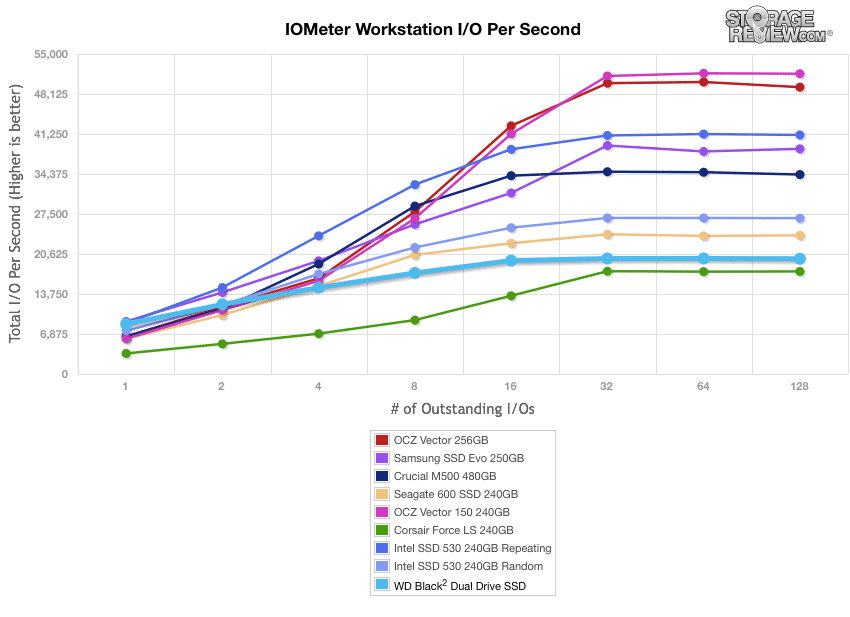
SSD Consumer Real-World Benchmarks
The first real-life test is our HTPC scenario. In this test we include: playing one 720P HD movie in Media Player Classic, one 480P SD movie playing in VLC, three movies downloading simultaneously through iTunes, and one 1080i HDTV stream being recorded through Windows Media Center over a 15 minute period. Higher IOps and MB/s rates with lower latency times are preferred. In this trace we recorded 2,986MB being written to the drive and 1,924MB being read.
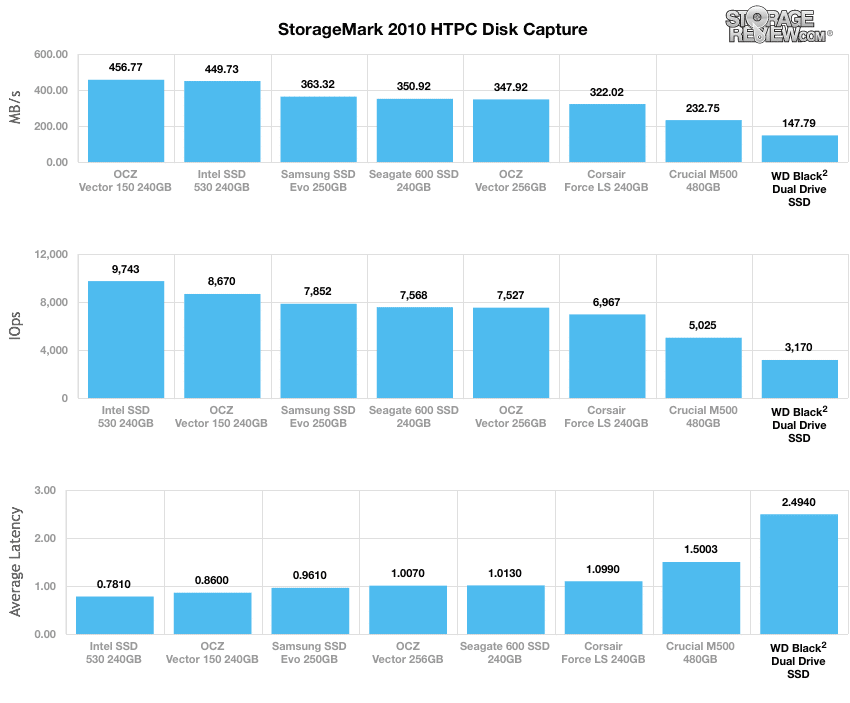
In our HTPC profile, the WD Black2 averaged 147MB/s or 3,170 IOPS, coming in far below other mainstream SSDs.
Our second real-life test covers disk activity in a productivity scenario. For all intents and purposes this test shows drive performance under normal daily activity for most users. This test includes: a three hour period operating in an office productivity environment with 32-bit Vista running Outlook 2007 connected to an Exchange server, web browsing using Chrome and IE8, editing files within Office 2007, viewing PDFs in Adobe Reader, and an hour of local music playback with two hours of additional online music via Pandora. In this trace we recorded 4,830MB being written to the drive and 2,758MB being read.
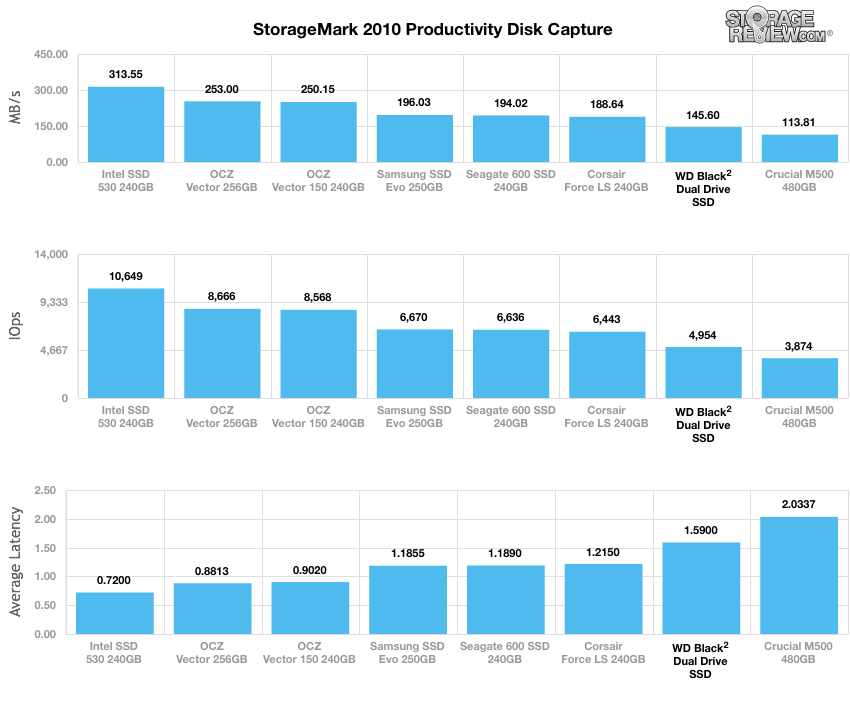
In our Productivity trace, the WD Black2 measured 145MB/s average or 4,954 IOPS, trailing the group although not the lowest which was the Crucial M500 480GB SSD.
Our third real-life test covers disk activity in a gaming environment. Unlike the HTPC or Productivity trace, this one relies heavily on the read performance of a drive. To give a simple breakdown of read/write percentages, the HTPC test is 64% write, 36% read, the Productivity test is 59% write and 41% read, while the gaming trace is 6% write and 94% read. The test consists of a Windows 7 Ultimate 64-bit system pre-configured with Steam, with Grand Theft Auto 4, Left 4 Dead 2, and Mass Effect 2 already downloaded and installed. The trace captures the heavy read activity of each game loading from the start, as well as textures as the game progresses. In this trace we recorded 426MB being written to the drive and 7,235MB being read.
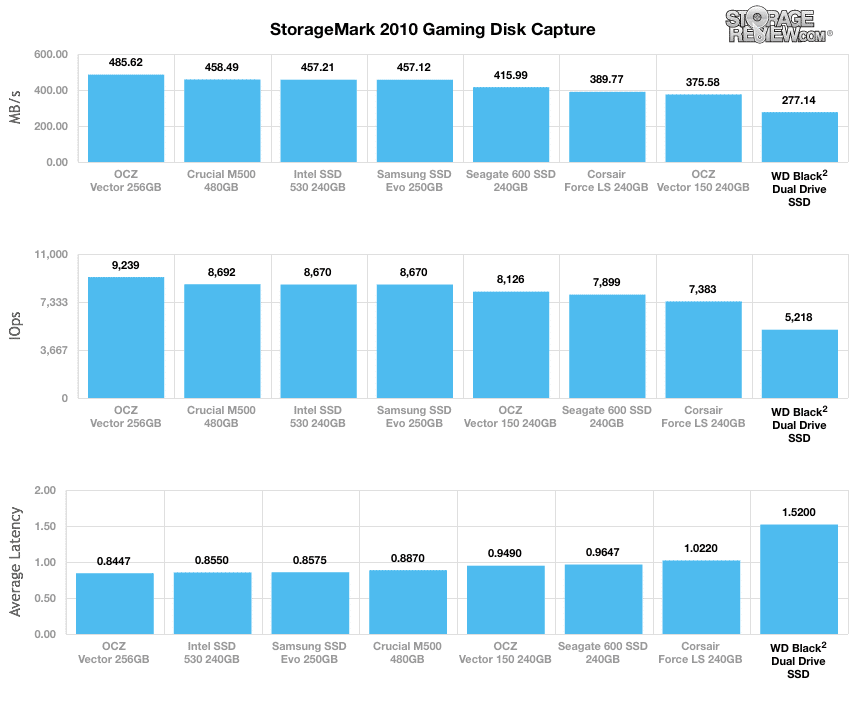
In our read-heavy Gaming trace, the WD Black2 measured just 277MB/s average or 5,218 IOPS, coming in at the bottom of the other mainstream SSDs.
Simultaneous HDD/SSD Performance
After testing each drive individually, we attempted to hit both drives at the same time to see what happens when the Marvell traffic cop controller gets stressed. When both drives received read or write activity, they were responsive, but performance drops if both devices are accessed at the same time where individual speeds would measure in excess of 500MB/s. This means if the SSD can offer read speeds of 450MB/s and the HDD 110MB/s read, total performance will never exceed the limit of a SATA 6Gb/s port. In early tests when the drives received opposite workloads however, the tests locked up indicating that the controller may not be able to handle multiple streams of conflicting read/write activity in certain scenarios. Rebooting the system and reinstalling the drivers which recreated the partition mapping did resolve the issue, but it’s worth noting that the drive failed to perform as it should under our testing scenario. WD acknowledges that future firmware releases will continue to enhance the stability and performance of the product, so it’s possible that multi-drive performance will improve over time.
Power Consumption
With any laptop drive, power consumption is an important factor. The key sources of power draw get narrowed down to either the bright screen or the storage device used. In the next test, we record the average power consumed over a small range of synthetic benchmarks.

Comparing power consumption of the WD Black2 to the Blue Slim that it is based around (plus SSD), the Black2 HDD consumed more power in all areas than the HDD alone. This wasn’t completely unexpected given the dual-drive nature of this product, but it also highlights one problem for a device such as this. Even if only one part of the device is active, the other side is sitting idle and consuming power at all times. This means that compared to an SSD or HDD alone, the Black2 will always draw more power than either single device most situations.
Conclusion
The WD Black2 is a extremely innovative combo drive that presents both 1TB of HDD storage and 120GB of SSD storage to the host system. The 9.5mm 2.5″ form factor slots in standard notebook drive bays and connects via SATA interface. A third controller manages the IO for each drive based on which partition is being accessed. The Black2 ships currently in a single 1TB/120GB configuration with an MSRP of $299.
Looking at performance, the Black2 HDD section is nearly identical to the Blue Slim which it is based on. From its 1TB of storage we measured sequential access speeds of 106MB/s read and 107MB/s write, which for bulk notebook storage is very respectable. We did notice a slight dip in performance compared to the WD Blue Slim alone, although with the custom SATA bridge there is bound to be a mild hit compared to native performance. When it comes to SSD performance, the Black2 slumped compared to other mainstream SSDs in the majority of our benchmarks. While read performance did surpass WD’s quoted 350MB/s figure at 449MB/s, write performance came in at 138MB/s. These figures are impressive compared to existing hybrid HDDs on the market, but they severely lag behind dedicated mainstream SSDs.
There’s no doubt the Black2 is cool, but cool on its own isn’t enough to warrant a purchase. We’ve already highlighted some of the market acceptance issues WD will have, including the lack of Mac support and the reality that many notebooks offer a way to get a second flash-based drive into the system. The fact is, the Black2 also faces acceptance issues because neither drive is very fast, and in some situations users may find system performance issues when the drives are both accessed at the same time. The other major challenge, even if we accept that a user may not be able to fit a dedicated HDD and SSD into a system, is the pricing of the Black2. At launch the MSRP is $299, which is close to the price of 500GB SSDs like the Crucial m500 and Samsung EVO. While a user going that route obviously gives up capacity, they gain orders of magnitude more speed, system performance and battery life. With the prevalence of cloud storage solutions and the low cost and good design of portable external drives that are available up to 2TB, it’s difficult to argue in favor of the sandwiched drive solution at this time. The concept however has potential and it’s encouraging that WD is pressing forward with designs that are innovative and creative, even if this particular iteration isn’t quite there.
Pros
- Novel and impressive engineering
- Hardware compatible with any Windows system that supports 9.5mm drives
- Better in many ways than hybrid hard drives
Cons
- SSD performance is weak compared current mainstream comparables
- When both drives are taxed, performance of the SSD drops
- Compatible with Windows only
Bottom Line
The WD Black2 deserves plaudits for its innovative design. Unfortunately outside of fringe use cases, there aren’t many applications where this configuration is a perfect fit. The high launch MSRP and the lack of Mac support further limits its potential.
WD Black2 at Amazon




 Amazon
Amazon